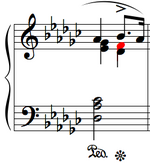| This article has not yet been rated on Misplaced Pages's content assessment scale. It is of interest to the following WikiProjects: | |||||||||||
| |||||||||||
Sheet music
Shouldn't the pedal in the sheet music use the Ped. * method that Chopin used? Asmeurer (talk ♬ contribs) 19:30, 3 February 2007 (UTC)
- The image is simply a representation of the song, as one that should be used in a Thematic Index. I don't think that discrepency warrants a total replacement, but as I'm going through the rest of the étude pictures, I'll keep that in mind (unless of course, someone else decides to recreate it). z ε n 05:56, 4 February 2007 (UTC)
Page name
Sorry, I screwed up twice. Someone please fix it to standardize. z ε n 03:01, 6 February 2007 (UTC)
"Only white key"
I don't see an F natural in bar 66 of this etude, so I've removed that line for now. --HappyCamper 01:44, 18 March 2007 (UTC)
- Erm...nevermind. I see it now. It's not marked with an accidental :-) --HappyCamper 01:47, 18 March 2007 (UTC)
- I reverted it. Perhaps a picture of bar 66 to show the white key would add to the article. Asmeurer (talk ♬ contribs) 02:27, 19 March 2007 (UTC)

- A picture picture, or fabrication in Finale? I can provide both. ALTON .ıl 06:22, 19 March 2007 (UTC)
- I see that you are Zen. One that matches the picture on the top right would be best. I don't know how to work LilyPond, but would it be possible to make the F-natural red or in some way highlight it (I'm assuming that the top right score was done in LilyPond)? Of course, this is just a suggestion that I'm throwing out there. Only add it if you think it will add to the article and won't seem to crowded. Asmeurer (talk ♬ contribs) 00:00, 20 March 2007 (UTC)
- How's this? I write all these in Finale, and do "post-production" in the GIMP. ALTON .ıl 00:25, 20 March 2007 (UTC)
- Hmmm...I don't know if this is really encyclopedic though...I mean, this note is actually part of a cadence and not really part of the 16th-note-triplets that characterise the piece. Maybe we can add it in a trivia section though. Thoughts? --HappyCamper 02:03, 20 March 2007 (UTC)
- Its the "Black Key Etude", the fact that there is only one white key in the right hand is more than just a note of trivia. Its a bit curious as to why he didn't go the extra step and remove all the white keys in the right hand of the composition. Does the white key stick out when you listen to it? I'm for including it, but I think it should be balanced with more discussion about what having black keys in the right hands means. Was it just a gimmick, or does Chopin achieve some sort of 'pentatonic scale' effect? That is, include the white key discussion but don't let it take over the entire article. DavidRF 14:31, 20 March 2007 (UTC)
- Ah, yes, that picture doesn't match the one in the box, though it looks better than it. It was exactly what I had in mind. My score doesn't have the accent over the note, though, but it could be an edit on the part of my score.
- As far as DavidRF's comment, I know that Chopin didn't nickname any of his pieces, so the name "Black Key" would have been someone else's (I just noticed that this isn't in the article, does anyone know who named it?). Bar 66 is important musically: it contains the only quarter notes in the right hand before the end (unless I missed one). This represents a slowing down from the Vivace right before the end of the piece (kind of hard to explain, but there is an audio file). Furthermore, it comes just after the climactical high E-flat in bar 65. The new F-natural gives it a musical completion that I can't really describe (listen closely to the file or play it). As far as to why he only included black keys instead of the F, it's an Etude and it's in the key of G-Flat major. I do agree that more discussion is needed about this. That is the highlight of the piece, after all. Asmeurer (talk ♬ contribs) 02:56, 21 March 2007 (UTC)
- Yes, it offers a good cadence into the Coda, but no matter how accurate anyone's dissertation is, it's all OR until someone can cite something. Was it you that had Rosen's other book? I have Piano Notes but it doesn't have anything on that note. Maybe Whiteside or Huneker commented on it. ALTON .ıl 03:58, 23 March 2007 (UTC)
- I added something. Verify its content. ALTON .ıl 09:29, 25 March 2007 (UTC)
Ternary form??
I do not know who wrote this, but he is wrong! There is not enough musical contrast to call the middle section a B-section!
The work is simply in BINARY form: Exposition of the theme, little developement (with a very long retransition) and reexposition.
The development is not a new musical idea, its lacks 'entity'. Chopin's Etudes Op.25 No.5 and Op.2 No.10 are in ternary form (just compare!!) but this one is not.
Thanks. —Preceding unsigned comment added by 81.184.12.213 (talk) 13:14, 23 April 2011 (UTC)
Categories: